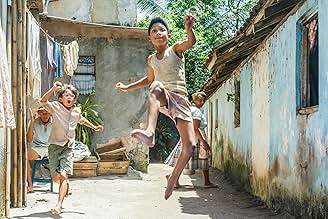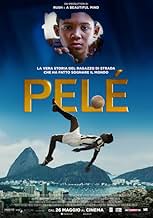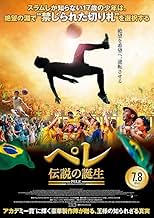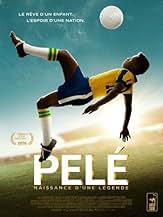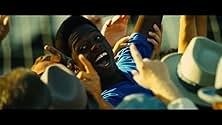IMDb रेटिंग
7.1/10
22 हज़ार
आपकी रेटिंग
17 साल की उम्र में साओ पाउलो की मलिन बस्तियों से पेले की उल्कापिंड वृद्धि ब्राजील को अपनी पहली विश्व कप जीत तक ले जाने के लिए इस जीवनी नाटक में दिखाई गई है.17 साल की उम्र में साओ पाउलो की मलिन बस्तियों से पेले की उल्कापिंड वृद्धि ब्राजील को अपनी पहली विश्व कप जीत तक ले जाने के लिए इस जीवनी नाटक में दिखाई गई है.17 साल की उम्र में साओ पाउलो की मलिन बस्तियों से पेले की उल्कापिंड वृद्धि ब्राजील को अपनी पहली विश्व कप जीत तक ले जाने के लिए इस जीवनी नाटक में दिखाई गई है.
- निर्देशक
- लेखक
- स्टार
Phil Miler
- Narrator
- (वॉइस)
Eric Bell Jr.
- Zoca
- (वॉइस)
फ़ीचर्ड समीक्षाएं
I was invited to the world premier of this film at the TriBeCa Film Festival, in New York. I say invited, as if my life is some sort of glamorous affair. In reality, a mate at work couldn't make it, and he knew I'd have no actual plans, so I eagerly obliged.
Just before the movie started, the 350 or so people in the audience got what they wanted, as the man himself stood up and raised his hand to the instagram happy crowd. Just knowing Pele was in the audience gave the room a little extra energy.
Perhaps a little naive, I knew a little about Pele's playing career but little of the man and, the journey to what he became. The film follows his early years with friends at home, up until he becomes 17 and plays for Brazil in the 1958 World Cup in Sweden. There's enough humour, big laughs, drama, and passion in the film that will translate to fans familiar with the legend and those who may have only heard of him.
The real treat, were the applause, and cheering from the audience when the on-screen Pele scored. His hand went up in recognition and the cheers got louder. I was pleased that despite the film keeping my attention he may have nodded off, he's knocking on a bit.
I waited outside afterward and managed to get a signed Santos shirt from him, which kinda gave me goose pimples, and rammed home the magnitude of who this man was, and what he had done for the game. My dad would have been proud. Sadly the shirt is the guys from work, so I'm currently deciding whether to buy a replica shirt and say I didn't get it, or beginning to practice the man's signature! That's okay, isn't it...
I did snap a selfie. Insta - Jamesbydesign
Just before the movie started, the 350 or so people in the audience got what they wanted, as the man himself stood up and raised his hand to the instagram happy crowd. Just knowing Pele was in the audience gave the room a little extra energy.
Perhaps a little naive, I knew a little about Pele's playing career but little of the man and, the journey to what he became. The film follows his early years with friends at home, up until he becomes 17 and plays for Brazil in the 1958 World Cup in Sweden. There's enough humour, big laughs, drama, and passion in the film that will translate to fans familiar with the legend and those who may have only heard of him.
The real treat, were the applause, and cheering from the audience when the on-screen Pele scored. His hand went up in recognition and the cheers got louder. I was pleased that despite the film keeping my attention he may have nodded off, he's knocking on a bit.
I waited outside afterward and managed to get a signed Santos shirt from him, which kinda gave me goose pimples, and rammed home the magnitude of who this man was, and what he had done for the game. My dad would have been proud. Sadly the shirt is the guys from work, so I'm currently deciding whether to buy a replica shirt and say I didn't get it, or beginning to practice the man's signature! That's okay, isn't it...
I did snap a selfie. Insta - Jamesbydesign
I want to state first that I do really like Pélé, he is one of the best athletes in history, not only in his athletic performance but also in his conduct outside the pitch.
His compelling personality is well displayed and I cannot speak with certainty about his background, but I suspect that while it was challenging it was perhaps not quite as bad as it is displayed at times.
My main problem with the movie is the display of the national teams aside from the brazilians. It was at this time and unlike the depiction of the movie well known that Brazil was a good team, perhaps not the favorites to win, but by no means a complete underdog. The favorites to win were West Germany, France and the Soviet Union. Sweden who is antagonisticly depicted was a nation with many players at the very end of their career and though the population was excited at their nations participation and that for the first time (for the swedes) professional players playing in clubs abroad would be permitted to play for the national team. So people were hopeful that with homefield advantage and the addition of a handful of worldclass professionals though perhaps past their prime(Niels Liedholm 36 at the time and Gunnar Gren 38) that maybe possibly Sweden could win.
So the primary factual error here is that Brazil was by no means colossal underdogs and the Swedes were not as massively favored as depicted and certainly not as arrogant and demeaning as they are shown. Though there is some truth in their strategy in the final game, the swedes did hope to try and score an early goal hoping the brazilians would be unable to recover.(According to Niels Liedholm).
I also find it unfortunate that while racism is horrible and was certainly present even amongst my own swedish ancestors. It is very unfortunate that this media never depicted some of the really inspiring moments of people in this tournament. Because in the end Pélé have stated that the swedish king at the time went down to meet the players on both sides and shook everybodys hand and chatted with them regardless of what they looked like. For many people just like the king football have no color and whilst Péle has had to deal with his fair share of racism he has seldom dwelt on the negative, but almost always uplifted the positive.
For my parents who vividly remember this tournament and who have always held Pélé in very high regard as both a footballer and a person. It was rather difficult to swallow the depiction of his opponents(our national team in particular) and that of the tournament as a whole which is perhaps one of the most memorable world cups in history with Pélé the 17-year old wunderkind and Just Fontaine who set a record of scoring goals that to this day stands.
His compelling personality is well displayed and I cannot speak with certainty about his background, but I suspect that while it was challenging it was perhaps not quite as bad as it is displayed at times.
My main problem with the movie is the display of the national teams aside from the brazilians. It was at this time and unlike the depiction of the movie well known that Brazil was a good team, perhaps not the favorites to win, but by no means a complete underdog. The favorites to win were West Germany, France and the Soviet Union. Sweden who is antagonisticly depicted was a nation with many players at the very end of their career and though the population was excited at their nations participation and that for the first time (for the swedes) professional players playing in clubs abroad would be permitted to play for the national team. So people were hopeful that with homefield advantage and the addition of a handful of worldclass professionals though perhaps past their prime(Niels Liedholm 36 at the time and Gunnar Gren 38) that maybe possibly Sweden could win.
So the primary factual error here is that Brazil was by no means colossal underdogs and the Swedes were not as massively favored as depicted and certainly not as arrogant and demeaning as they are shown. Though there is some truth in their strategy in the final game, the swedes did hope to try and score an early goal hoping the brazilians would be unable to recover.(According to Niels Liedholm).
I also find it unfortunate that while racism is horrible and was certainly present even amongst my own swedish ancestors. It is very unfortunate that this media never depicted some of the really inspiring moments of people in this tournament. Because in the end Pélé have stated that the swedish king at the time went down to meet the players on both sides and shook everybodys hand and chatted with them regardless of what they looked like. For many people just like the king football have no color and whilst Péle has had to deal with his fair share of racism he has seldom dwelt on the negative, but almost always uplifted the positive.
For my parents who vividly remember this tournament and who have always held Pélé in very high regard as both a footballer and a person. It was rather difficult to swallow the depiction of his opponents(our national team in particular) and that of the tournament as a whole which is perhaps one of the most memorable world cups in history with Pélé the 17-year old wunderkind and Just Fontaine who set a record of scoring goals that to this day stands.
Like the excellent Kevin Costner film: "McFarland USA" this movie sensitively shows how sport can significantly alter a people's identity (in this case the entire nation of Brazil was uplifted from a sense of inferiority within the world community, to a pride in their own uniqueness). The acting is good. The sports action scenes are remarkable (how did they get an actor with such great soccer skills?) and the music is by the great A.R. Raman. A lot of care was put into the making of this film, but a lot was lost, I feel, by having the actors speak mostly in English. And it wasn't dubbed English, it was the Brazilian actors trotting out their heavily accented English. That had the effect of taking away much of the authenticity the film had worked so hard to achieve. (That the real-life Pelé has a cameo appearance - and thus takes the viewer out of the scene's intended verisimilitude - is, perhaps, excusable - I can cut it that slack). One more grumble: the movie trailers announced: "With Rodrigo Santoro". I will see anything with him in it - he is a terrific actor. But he appears for LITERALLY FIVE SECONDS! Really! That is unacceptable marketing...'bait and switch', actually. But see the movie anyway. (BTW, I met Pelé in 1984. We talked for about ten minutes, and at one point, after we had been briefly interrupted, he put his arm around me and said: "So, my Brazilian-American friend, where were we?" He had a golden air about him, and yet was completely down-to-earth even though we talked about cosmic reality. To listen to my five minute audio recording about meeting Pelé, search for "Pelé And His Brazilian- American Friend".
Pelé: Birth of a Legend is an extraordinary movie, the tale of how Pelé became famous and won with Brazil their first world cup in the 1958 world cup in Sweden. This is probably the most successful movie that focuses on soccer. A true story of a boy with nothing who became the world's greatest soccer player. No famous actors in this film except for Vincent D'Onofrio. But the movie doesn't need famous actors to attract the attention of the viewers, it's beautiful story is what attracted me in the first place. Along with the music composed by A. R. Rahman That follows the emotion and scenes throughout the film. Pelé's legend is worth to be told and has a deep meaning to Brazil's history of soccer and hope of becoming the best. The movie is also a story of restoring honor and hope to a full nation. Only it is sad that today Brazil's soccer team can't be as great as it was back then. So this film brings a lot of nostalgia towards the past and a better hope for the future. I am hoping to see other movies about soccer like this one in the future, maybe a movie about Neymar or Messi.
Brazilian teams play a style of soccer all their own. (Yeah, I called it soccer. Gimmie a break. I'm an American.) They call that style "ginga". It's a very fluid kind of play that emphasizes creative ball control. Some call this style of play "flamboyant". Others dismiss it as "trick plays". Brazilians simply think of it as
their heritage. The Urban Dictionary's definition of ginga states, in part, "Ginga is creativity... the opposite of mechanical soccer. It is having fun with the ball. It is grace. It is being fluid and coordinated. IT IS SOUL. IT IS DANCE." A June 15, 2014 "New York Times" article explains the development of ginga this way: "
an imaginative style of play that made competition and gratifying playfulness inseparable, with blacks and people of mixed race rising from exclusion and becoming its main protagonists." Ginga is a unique mixing of the skills of samba dancers with Brazilian martial arts fighters, all applied to the game of soccer, turning it into, as the Brazilians call it, "the beautiful game", while also celebrating Brazil's different races and cultures. The focus on ginga in the biopic "Pelé: Birth of a Legend" (PG, 1:47) educates its audience, celebrates that style of soccer and captivates Movie Fans with the true rags-to-riches story of the greatest soccer player ever, a man known all around the world simply as
Pelé.
As the film opens, the nearly 10-year-old Pelé (born Edson Arantes do Nascimento, and called "Dico" by his family and friends) is watching a television broadcast as his native Brazil loses the 1950 World Cup to Uruguay. Brazil's loss was a huge upset, a phrase which also describes the emotions of Brazil's soccer fans (which was basically everybody). The entire country was shocked, humiliated and demoralized. Dico (Leonardo Lima Carvalho) promises his father, a former soccer player known as Dondinho (played by Brazilian musician/actor Seu Jorge), that he, Dico, will one day bring Brazil a World Cup Championship.
Dico's family is so poor that Dico doesn't even own a soccer ball – or even a pair of shoes, but the kid manages to develop his natural talent anyway. Under his father's tutelage, he learns ball-handling by juggling and kicking grapefruits and he plays on a local team with his friends. Their team is literally called "The Shoeless Ones" and is mercilessly mocked by the town's rich kids, who single out Dico for a special measure of abuse and start calling him "Pelé". It's a made-up name which is meant to be an insult, and Dico hates the name, but as he works through his anger by helping his team play better than expected on the soccer field, the name sticks, and "Pelé" becomes synonymous with Dico and his amazing talent.
Continuing to hone his skills on his own time and play brilliantly on the field in spite of having to endure prejudice and personal tragedy, Pelé (played as a teenager by Kevin de Paula) is recruited and mentored by former player Waldemar De Brito (Milton Gonçalves). Pelé's talent gets him a spot on a professional soccer club, Santos FC, and then on Brazil's national team, all before he reached the age of 17. On the national team, Pelé's coach is Vicente Feola (Vincent D'Onofrio), the latest in a series of coaches who tries to beat Pelé's individuality out of him and force him to play a more traditional and "sophisticated" European style. Many Brazilians blamed the ginga style of play for the 1950 World Cup loss, but ginga is Pelé's strength. Pelé finds himself struggling with his coach's instruction, and an old adversary turned teammate, plus a significant knee injury, all while the national team prepares for the 1958 World Cup tournament and a possible championship matchup against the heavily-favored team representing the host country of Sweden, coached by the arrogant and condescending George Raynor (Colm Meaney).
"Pelé: Birth of a Legend" represents formulaic and unrefined filmmaking, but still manages to inspire on multiple levels. Co-written and co-directed by brothers Jeff and Michael Zimbalist (both working on their first feature film), the movie follows the tried-and-true pattern of most sports movies, but suffers from some minor issues of technique. The script sometimes stops short of completing its thoughts and the film is a bit over-edited, making the viewer feel like something is missing in a few of the scenes. Some characters are underdeveloped and some of the acting is shaky, but the main characters (especially D'Onofrio, Jorge and de Paula) all give strong performances. The film spends too much time on Pelé's childhood and not enough time on his rise through the ranks of Brazilian soccer, but does convey why Pelé was so good and wisely culminates with the '58 World Cup, at which point it's clear that all the pieces are finally in place for Pelé's eventual worldwide fame and unparalleled success. In spite of the film's lack of originality and other relatively minor problems, the Zimbalist brothers and their cast and crew give us plenty to shout about during the film's third act and leaves us with important lessons about determination, resilience and playing to our strengths, as well as the importance and strength of diversity. As much as I enjoyed "Pelé: Birth of a Legend" (especially its emotional ending), after fairly weighing all of its strengths and weaknesses, the most I can give it is a mild recommendation: "B"
As the film opens, the nearly 10-year-old Pelé (born Edson Arantes do Nascimento, and called "Dico" by his family and friends) is watching a television broadcast as his native Brazil loses the 1950 World Cup to Uruguay. Brazil's loss was a huge upset, a phrase which also describes the emotions of Brazil's soccer fans (which was basically everybody). The entire country was shocked, humiliated and demoralized. Dico (Leonardo Lima Carvalho) promises his father, a former soccer player known as Dondinho (played by Brazilian musician/actor Seu Jorge), that he, Dico, will one day bring Brazil a World Cup Championship.
Dico's family is so poor that Dico doesn't even own a soccer ball – or even a pair of shoes, but the kid manages to develop his natural talent anyway. Under his father's tutelage, he learns ball-handling by juggling and kicking grapefruits and he plays on a local team with his friends. Their team is literally called "The Shoeless Ones" and is mercilessly mocked by the town's rich kids, who single out Dico for a special measure of abuse and start calling him "Pelé". It's a made-up name which is meant to be an insult, and Dico hates the name, but as he works through his anger by helping his team play better than expected on the soccer field, the name sticks, and "Pelé" becomes synonymous with Dico and his amazing talent.
Continuing to hone his skills on his own time and play brilliantly on the field in spite of having to endure prejudice and personal tragedy, Pelé (played as a teenager by Kevin de Paula) is recruited and mentored by former player Waldemar De Brito (Milton Gonçalves). Pelé's talent gets him a spot on a professional soccer club, Santos FC, and then on Brazil's national team, all before he reached the age of 17. On the national team, Pelé's coach is Vicente Feola (Vincent D'Onofrio), the latest in a series of coaches who tries to beat Pelé's individuality out of him and force him to play a more traditional and "sophisticated" European style. Many Brazilians blamed the ginga style of play for the 1950 World Cup loss, but ginga is Pelé's strength. Pelé finds himself struggling with his coach's instruction, and an old adversary turned teammate, plus a significant knee injury, all while the national team prepares for the 1958 World Cup tournament and a possible championship matchup against the heavily-favored team representing the host country of Sweden, coached by the arrogant and condescending George Raynor (Colm Meaney).
"Pelé: Birth of a Legend" represents formulaic and unrefined filmmaking, but still manages to inspire on multiple levels. Co-written and co-directed by brothers Jeff and Michael Zimbalist (both working on their first feature film), the movie follows the tried-and-true pattern of most sports movies, but suffers from some minor issues of technique. The script sometimes stops short of completing its thoughts and the film is a bit over-edited, making the viewer feel like something is missing in a few of the scenes. Some characters are underdeveloped and some of the acting is shaky, but the main characters (especially D'Onofrio, Jorge and de Paula) all give strong performances. The film spends too much time on Pelé's childhood and not enough time on his rise through the ranks of Brazilian soccer, but does convey why Pelé was so good and wisely culminates with the '58 World Cup, at which point it's clear that all the pieces are finally in place for Pelé's eventual worldwide fame and unparalleled success. In spite of the film's lack of originality and other relatively minor problems, the Zimbalist brothers and their cast and crew give us plenty to shout about during the film's third act and leaves us with important lessons about determination, resilience and playing to our strengths, as well as the importance and strength of diversity. As much as I enjoyed "Pelé: Birth of a Legend" (especially its emotional ending), after fairly weighing all of its strengths and weaknesses, the most I can give it is a mild recommendation: "B"
क्या आपको पता है
- ट्रिवियाThe Old Guy in suit who's tea was dropped by the Brazilian team at the hotel before the Final of 1958 World cup was actually the real Pele as himself.
- गूफ़In the film, Pelè's mother is a servant in Josè Altafini "Mazzola's" home. In real life, both Pelè and Altafini were from modest families. They also lived in different towns.
- क्रेज़ी क्रेडिटThe end credits include the disclaimer that "The persons and events in this motion picture are fictitious. Any similarity to actual persons or events is unintentional." Which is of course ridiculous considering this is a biopic of Pelé loaded with real events (like the 1958 world cup).
- कनेक्शनFeatures 1958 FIFA World Cup (1958)
टॉप पसंद
रेटिंग देने के लिए साइन-इन करें और वैयक्तिकृत सुझावों के लिए वॉचलिस्ट करें
- How long is Pele: Birth of a Legend?Alexa द्वारा संचालित
विवरण
- रिलीज़ की तारीख़
- कंट्री ऑफ़ ओरिजिन
- आधिकारिक साइट
- भाषाएं
- इस रूप में भी जाना जाता है
- Pele: Birth of a Legend
- फ़िल्माने की जगहें
- उत्पादन कंपनियां
- IMDbPro पर और कंपनी क्रेडिट देखें
बॉक्स ऑफ़िस
- US और कनाडा में सकल
- $57,046
- US और कनाडा में पहले सप्ताह में कुल कमाई
- $7,226
- 15 मई 2016
- दुनिया भर में सकल
- $78,46,608
- चलने की अवधि
- 1 घं 47 मि(107 min)
- रंग
- पक्ष अनुपात
- 2.35 : 1
इस पेज में योगदान दें
किसी बदलाव का सुझाव दें या अनुपलब्ध कॉन्टेंट जोड़ें



